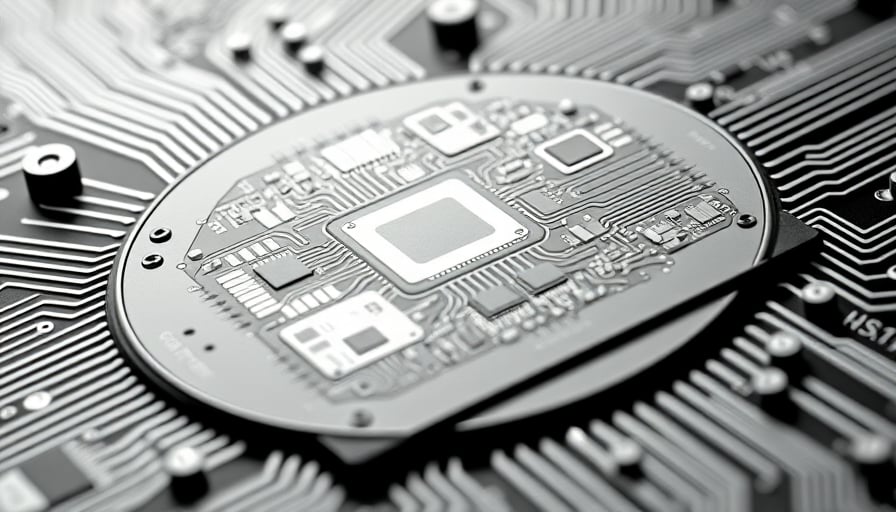Corporate Analysis: AMD’s Strategic Positioning Amidst Rapid Semiconductor Evolution
Executive Summary
Advanced Micro Devices Inc. (AMD) stands at a pivotal juncture as it prepares to report third‑quarter earnings. Brokerage houses have maintained a “buy” stance, citing price targets in the high‑$250 range, while institutional sentiment remains bifurcated—options flows lean bullish, yet a non‑trivial bearish exposure persists. CEO Lisa Su’s announcement of a multi‑year partnership with OpenAI signals an aggressive push into high‑performance artificial‑intelligence (AI) workloads, a move that could materially elevate AMD’s revenue trajectory. Concurrently, Amazon’s divestiture of its AMD stake—announced via a regulatory filing—adds a layer of uncertainty to the company’s shareholder composition, though the underlying motives remain opaque. This analysis evaluates how AMD’s strategic initiatives align with broader semiconductor technology trends, node progression, and manufacturing dynamics.
Node Progression and Yield Optimization
- Advanced Process Nodes
- AMD’s latest EPYC and Radeon RX platforms are built on TSMC’s 5 nm FinFET process, with forthcoming 3 nm nodes slated for the 2025–2026 window.
- The 5 nm node has delivered a 15 % power‑density improvement over 7 nm, enabling higher clock frequencies without proportionate thermal penalties.
- Yield optimization at 5 nm hinges on advanced defect control: inline defect density is below 1 cm⁻², and advanced lithography tools (EUV) reduce mask‑induced variability.
- Defect Management and Yield Gains
- Yield curves have plateaued at the 95 % mark for 5 nm dies; further gains require deeper process‑level integration of in‑line defect inspection (ALD‑based sensors).
- AMD’s design for manufacturability (DFM) team has implemented “early‑stage layout compaction” to mitigate lithography hotspots, a strategy that directly translates to higher die yields.
- Process‑Technology Integration
- Integration of “thin‑gate” FinFET structures and “high‑κ/metal‑gate” stacks has reduced short‑channel effects, a critical factor as nodes shrink below 5 nm.
- The synergy between transistor scaling and 3D packaging (e.g., Foveros) is expected to sustain performance gains while containing die size and cost.
Manufacturing Processes and Industry Dynamics
| Aspect | Current Status | Challenges | Implications for AMD |
|---|---|---|---|
| Capital Equipment Cycle | TSMC’s 3 nm EPIC tool procurement cycle extends 12–15 months; EUV lithography budgets exceed $1 bn per unit. | Equipment lead times limit ramp‑up; high capital expenditures strain supply chain financing. | AMD must coordinate with TSMC to lock in tool bookings early; delays could postpone EPYC 3 nm launch. |
| Foundry Capacity Utilization | TSMC’s 5 nm foundry capacity utilization at 68 % (2024 Q3). | Limited throughput may delay high‑volume shipments for AMD’s data‑center portfolio. | AMD’s design schedule must accommodate potential bottlenecks; may need to stagger product launches. |
| Design Complexity vs. Manufacturing Capabilities | Advanced AI accelerators require >100 k gates per compute tile, with tight timing constraints. | Maintaining clock speed while keeping power within thermal limits demands robust EDA tooling and rigorous timing closure. | AMD’s AI partnership with OpenAI necessitates a design‑in‑silico verification pipeline that can handle multi‑core, heterogeneous workloads. |
Capital Equipment Cycles and Cost Structures
Tool Procurement and Depreciation
TSMC’s EUV line depreciates over a 7‑year cycle; each new line requires a $600–$800 M investment.
AMD’s revenue contribution from high‑performance processors must offset these amortization costs, a relationship that intensifies as node scaling yields diminish.
Economies of Scale
As AMD’s EPYC line gains market share, incremental volume discounts on die fabrication become attainable, mitigating per‑unit cost pressures.
However, the shift toward 3D packaging introduces new supply‑chain nodes (interposer, TSV manufacturing) that require separate cost analyses.
Semiconductor Innovations Enabling Broader Technology Advances
- AI‑Optimized Architecture
- AMD’s Zen 4 CPUs incorporate vector units capable of 16‑bit and 32‑bit matrix operations, a cornerstone of machine‑learning inference workloads.
- The integration of Radeon Instinct GPUs with Unified Memory Architecture (UMA) allows for seamless data sharing between CPU and GPU cores, reducing data transfer overheads critical to high‑throughput AI inference.
- Advanced Packaging
- Foveros 3D stacking enables the vertical integration of memory (e.g., HBM3) with logic dies, resulting in higher bandwidth and lower latency—a prerequisite for data‑center AI accelerators.
- Advanced fan‑out wafer‑level packaging (FOWLP) reduces package height, thereby decreasing signal propagation delays and enhancing power‑delivery efficiency.
- Materials and Device Innovations
- Adoption of high‑κ dielectrics (HfO₂) and metal‑gate stacks lowers gate‑leakage currents, contributing to overall power reductions in dense AI workloads.
- Emerging “fin‑to‑fin” transistor designs further minimize variability, supporting tighter timing closure across heterogeneous core arrays.
Outlook for AMD’s AI and Data‑Center Segments
OpenAI Partnership
The multi‑year collaboration is poised to generate substantial royalty revenue, contingent upon AMD’s ability to deliver AI‑accelerated hardware that meets OpenAI’s performance benchmarks.
The partnership will likely accelerate the adoption of AMD’s EPYC 5 nm and future 3 nm CPUs in OpenAI’s infrastructure, providing a revenue growth lever.
Market Reception
Despite bullish options activity, the recent third‑quarter earnings decline underscores investor demand for clearer evidence of sustained momentum across gaming and data‑center verticals.
AMD’s capacity to scale production, while maintaining high yields at advanced nodes, will be critical to meeting the elevated demand projected for AI workloads.
Competitive Landscape
Intel’s IDM‑2 strategy and Nvidia’s diversified GPU ecosystem pose competitive challenges; AMD must continue to innovate in silicon efficiency and chiplet integration to maintain differentiation.
Conclusion
AMD’s strategic focus on high‑performance, AI‑centric silicon, coupled with its alignment with TSMC’s advanced process nodes, positions the company favorably amid the semiconductor industry’s rapid evolution. Nonetheless, the technical challenges of node progression, yield optimization, and capital equipment cycles demand meticulous coordination across design, manufacturing, and supply‑chain functions. By leveraging advanced packaging, materials science breakthroughs, and robust DFM practices, AMD can translate semiconductor innovations into tangible business growth, reinforcing its competitive stance in data‑center and gaming markets while navigating the complexities inherent in next‑generation chip production.
